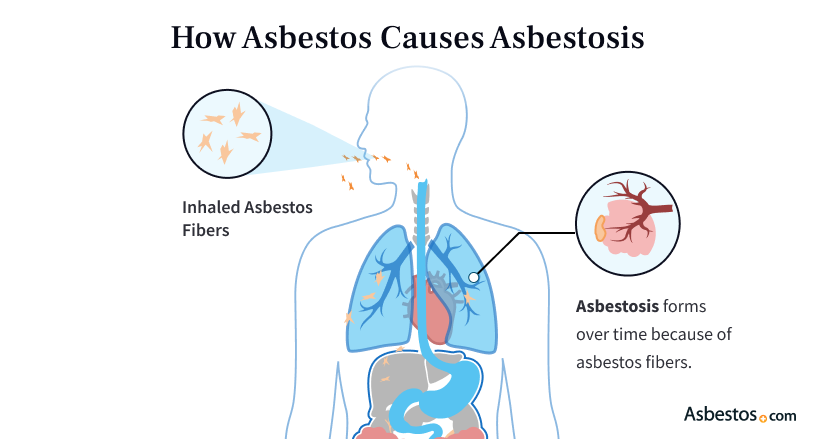Navy veteran Jerry Cochran developed asbestosis from exposure to asbestos-containing products. His faith and his work advocating for others has kept him going for the past half a century.
Asbestosis
Asbestosis is a chronic lung disease caused by inhaling asbestos fibers. These fibers can cause scarring, shortness of breath, a dry cough and chest pains. Eating a well-balanced diet and staying hydrated are ways to manage these symptoms.
What Is Asbestosis?
Asbestosis is a serious lung disease caused by asbestos exposure that results in lung scarring. Inhaled asbestos fibers cause inflammation and prevent the immune system from working properly. This can lead to scar tissue called pulmonary fibrosis forming in the lungs.
Scarring in the lungs makes them stiff and less able to provide the body with oxygen. As the scar tissue thickens and stiffens, gas exchange in the lungs becomes impaired. These changes lead to respiratory symptoms, including breathing problems, cough and chest pain.
Key Facts About Asbestosis
- Incurable lung disease that makes breathing progressively more difficult
- Usually develops after years of occupational asbestos exposure
- A contributing cause of death for approximately 600 to more than 1,000 Americans each year
- Signifies an elevated risk of developing asbestos-related cancer
There is no cure for asbestosis. Treatment can alleviate symptoms and slow disease progression. Asbestosis is not cancer. However, it signals a risk for cancer because of past asbestos exposure. These cancers include lung cancer and pleural mesothelioma. After being diagnosed with asbestosis, the chance of developing lung cancer is higher than that of mesothelioma.
Where Does Asbestos Exposure Occur?
Asbestos exposure for people diagnosed with asbestosis has happened at home, at work, and in the natural environment. Common locations of asbestos exposure include construction sites, ships and industrial areas. People working at these locations are at high risk of developing asbestosis.
Many different products contained asbestos before the 1980s. Examples include building materials, automotive parts, textiles and contaminated talc products. Although it is no longer mined in the U.S. or used in residential construction, the substance still exists in old building materials. Most experts do not consider occasional exposure sufficient to cause asbestosis.
An individual must have regular, prolonged exposure to asbestos to develop pulmonary fibrosis. As a result, occupational exposure is among the top causes of asbestosis.
Asbestosis Symptoms
The first symptoms of asbestosis include a dry cough, difficulty breathing and crackling sounds when breathing. These sounds are the result of scarring that stiffens the lungs.
Common Asbestosis Symptoms
- Chest pain or tightness
- Clubbing of fingers and toes
- Crackling sounds when breathing
- Fatigue
- Loss of weight and appetite
- Persistent dry cough
- Shortness of breath
The stiffened lungs also lower blood oxygen, causing shortness of breath. Long-term breathing issues and low oxygen result in fatigue and weight loss.
“Asbestosis symptoms can be similar to many illnesses or diagnoses, so your physician may not immediately consider it,” says Karen Selby, a registered nurse and Board-Certified Patient Advocate at The Mesothelioma Center. “Because of this, discussing your asbestos exposure history will be important. This will help your physician in ordering appropriate testing quickly.”
“Asbestosis symptoms can be similar to many illnesses or diagnoses, so your physician may not immediately consider it. Because of this, it will be important to discuss your asbestos exposure history. This will help your physician in ordering appropriate testing quickly.”

Advanced Asbestosis Symptoms
Advanced symptoms of asbestosis include pulmonary hypertension. Scar tissue can tighten arteries and lead to pulmonary hypertension. This makes blood pressure rise because the heart must work harder to pump blood to the lungs.
When the lungs deliver insufficient oxygen to the blood, a symptom called “clubbing” may arise. Clubbing causes the tips of the toes and fingers to be broader and rounder than usual. This symptom may occur early in disease progression for some patients.
Asbestosis takes less time to develop than asbestos-related cancer. An asbestosis diagnosis signals a risk of developing lung cancer or mesothelioma in the future.

Eating the right diet throughout mesothelioma treatment can ease your symptoms.
Get Free Recipes and TipsWhat Causes Asbestosis?
The only cause of asbestosis is asbestos exposure. Asbestosis is a form of pneumoconiosis, which is a condition caused by the inhalation of different types of dust. For example, silicosis is a form of pneumoconiosis from exposure to silica dust.
Inhaling asbestos fibers causes them to accumulate in the lungs. This leads to inflammation and fibrous changes in lung tissue over time. Scarring develops and tissue movement becomes limited. The interstitium (fluid-filled spaces that span the body, separating cells and blood vessels), alveoli and nearby tissue become inflamed and fibrotic.

An asbestos-related illness usually develops after years of regular exposure. The latency period from exposure to symptoms and diagnosis can be decades. Asbestosis has a shorter latency period of 20 to 30 years compared to asbestos-related cancers, which average 20 to 50 years.
Asbestosis Risk Factors
People who experience occupational asbestos exposure are at higher risk of asbestosis. Asbestosis tends to develop in people exposed to large amounts of asbestos over long periods.
Risk Factors for Asbestosis
- Amount and concentration of asbestos
- Size, shape and type of asbestos fibers
- Length of time of the exposure to asbestos
- Health factors such as smoking or a history of lung disease
- Genetic factors or specific mutations in DNA that increase risk of disease
Some workers have high-risk professions for heavy exposure. These jobs include construction workers, insulators, miners and millers. A 2024 study in the Scandinavian Journal of Work, Environment & Health also noted other high-risk workers. Pipefitters and metal, oil and shipyard workers are among them. Textile mill workers, industrial workers and mechanics are also at risk.
Family members of these workers encountered secondary exposure when asbestos fibers traveled home on clothing, shoes and tools. Secondhand asbestos exposure is known to cause mesothelioma, but it is not as likely to cause asbestosis. That’s because asbestosis is associated with high amounts of asbestos typically seen in direct workplace exposure.
Diagnosing Asbestosis
To diagnose asbestosis, doctors check medical and work records and conduct tests. Radiologists can identify signs of pulmonary fibrosis from an X-ray or CT scan. Doctors confirm the diagnosis when scan results and asbestos exposure history match.
Patients often receive lung tests to assess their lungs. Doctors use a stethoscope to detect crackling sounds in the lungs during inhalation. They’ll also use lung function tests to assess breathing capacity.
Biopsies of lung tissue can show fibrosis and asbestos fibers to confirm an asbestosis diagnosis. But a biopsy is not necessary when medical tests show fibrosis along with history of asbestos exposure.

Understand your diagnosis, top doctors and ways to afford care.
Get Your Free GuidePrognosis for Asbestosis
The median survival for asbestosis patients is about 10 years. Life expectancy varies with disease progression. Stage 1 patients live the longest, around 14 years. In contrast, stage 3 patients average just 1.75 years.
The outlook for asbestosis patients varies. It depends on how fast the disease progresses and the level of asbestos exposure. Those with high exposure tend to get severe cases that worsen quickly. Those with lower exposure often have mild cases that either progress slowly or remain stable.
| Asbestosis Stage | Survival in Months (Years) |
|---|---|
| Stage 1 | 171 months (14.25 years) |
| Stage 2 | 50 months (4.16 years) |
| Stage 3 | 21 months (1.75 years) |
| All Stages Combined | 124 months (10.3 years) |
There is no other way to reverse the scarring caused by asbestos exposure. Only a double lung transplant for asbestosis can halt progression. Asbestosis is the most frequently reported cause of pneumoconiosis deaths. It accounts for about 60% of pneumoconiosis deaths recorded from 1999 to 2018.
Asbestosis survivor Jerry Cochran didn’t know his time in the Navy would lead to an asbestosis diagnosis later in life. He encountered asbestos when he scraped and ground nonskid paint off an aircraft carrier in the early 1970s.
Asbestosis Treatment Options
Asbestosis has no cure, but certain patients with advanced cases have undergone lung transplants. Other treatments relieve symptoms, slow progression and improve quality of life. Asbestosis treatments include:
- Lung transplant
- Medications
- Physical therapy
- Pulmonary rehabilitation
- Smoking cessation
- Supplemental oxygen
Doctors consider lung transplants for advanced cases of asbestosis. Double lung transplants are most effective for asbestosis, but few patients qualify for this aggressive procedure.
Supplemental oxygen from a portable oxygen tank is often necessary for patients with reduced lung capacity. Medications can thin lung secretions to make coughing easier and relieve chest pain. Quitting smoking is important because cigarette smoke worsens the symptoms and progression of asbestosis.
Pulmonary rehabilitation aids patients with chronic breathing issues. A team of therapists may tackle physical and mental health. Exercise and physical therapy can boost fitness, lung function and quality of life. Chest physical therapists may use percussion and vibration to loosen and clear mucus.
Top Pulmonologists Treating Asbestosis
As the condition gets worse, patients need more treatment as they age. It’s important to see an asbestosis expert to manage the disease and symptoms.

Indianapolis, Indiana
Pleural Specialist | Pulmonary Critical Care
Expertise: Interventional Pulmonology Clinical Trials
Languages: English
Lung transplants are best for severe asbestosis or when the patient also has other lung diseases. This surgery is invasive and a last resort.
Some people feel better with therapies like acupuncture, massage and nutrition treatments. Changing your lifestyle can also help manage asbestosis. For example, quitting smoking can slow down the disease. Eating healthy foods, staying active, and getting enough sleep can help your body deal with the effects of asbestosis, such as low oxygen levels.
Common Questions About Asbestosis
- How long can you live with asbestosis?
-
Asbestosis is a chronic disease, unlike mesothelioma. Patients often live for decades. However, it can be deadly, and many struggle with severe breathing issues.
- What is the difference between asbestosis and mesothelioma?
-
Mesothelioma is a cancer that affects the tissue around the lungs, chest and abdomen. Asbestosis, however, is a chronic lung disease and not cancer. It’s a type of pulmonary fibrosis. Asbestosis and mesothelioma have the same cause as other asbestos-related diseases.
- Can asbestosis be cured?
-
You can live with asbestosis for years, but there is no cure for this progressive condition. Treatment options aim to reduce symptoms and help breathing. Patients live an average of 10 years with asbestosis.
- What questions should you ask your doctor?
-
- How advanced is my condition?
- What is the best treatment for asbestosis?
- What medications do you recommend, and what are the side effects?
- How much experience do you have managing asbestosis?
- Will I need a lung transplant?
- Am I at risk of developing mesothelioma or lung cancer?
- Is anyone in my family at risk?




